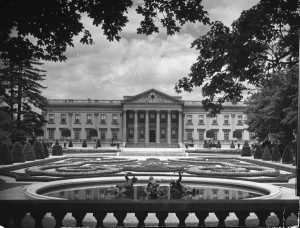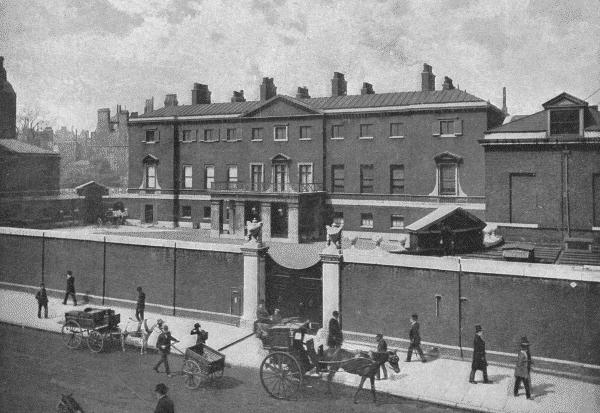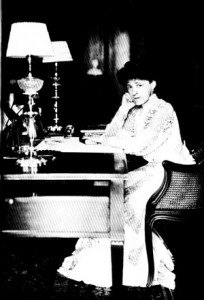
[Yahoo! News]Lynnewood Hall, a century-old stunner of a building just outside Philadelphia, silently, almost invisibly, languishes 200 feet beyond a two-lane blacktop road like a crumbling little Versailles.
The graceful fountain that welcomed hundreds of well-heeled visitors, President Franklin Roosevelt among them, was dismantled and sold years ago. Its once meticulously sculpted French gardens are overgrown with weeds and vines. The classical Indiana limestone facade may have lost its luster but its poise still remains — at least from the other side of rusted wrought iron gates that keep the curious at bay.
Like other Gilded Age palaces of the nation’s pre-Depression industrial titans, Lynnewood Hall is a relic of a bygone era facing an uncertain future. Will it befall the same fate as neighboring Whitemarsh Hall, the demolished mansion of banking magnate Edward Stotesbury? Or will it be returned to former glory, like industrialist Alfred I. duPont’s former Nemours Mansion in Delaware?
“It’s a tragedy that people drive past Lynnewood Hall and don’t know what it is, or don’t even notice it’s there,” said Stephen J. Barron, who runs a website and Facebook group aiming to drum up interest in the mansion’s plight. “It breaks my heart and it bothers me. The house is a work of art.”
Long before its current humble predicament, Lynnewood Hall was home to the uber-wealthy Widener family and called “the last of the American Versailles.”
The lord of Lynnewood Hall, Peter A.B. Widener, started out as a butcher. After making a small fortune supplying mutton to Union troops during the Civil War, he grew into a full-fledged tycoon from buying streetcar and railroad lines and investing in steel, tobacco and oil.
Among the spoils was his 480-acre estate, its centerpiece the 110-room, 70,000-square-foot Georgian-style palace designed by architect Horace Trumbauer.
Lynnewood Hall was completed in late 1900 and cost $8 million to build — a staggering $212 million in today’s dollars.
It had a ballroom that held 1,000 people, an indoor pool and squash court, a bakery and full-time upholstery and carpentry shops. The estate boasted its own power station, horse track and stables, and a 220-acre farm run by a staff of 100.
French landscape architect Jacques Greber designed the formal French gardens, which were graced by his brother Henri-Louis Greber’s fountain of bronze and marble statuary.
“It’s a great building and it has great potential for commercial use, especially for institutional use,” said Mary Werner DeNadai, principal of John Milner Architects in Chadds Ford. “It was certainly built to last.”
Contrary to accounts describing it as largely gutted, Lynnewood Hall is in surprisingly stable condition and generally intact, said DeNadai, who got a rare look inside in 2004 at the behest of an client interested in a possible purchase.
Her firm specializes in breathing new life into mothballed mansions, among them Nemours in Wilmington, Del., owned by a duPont-founded nonprofit and reopened in 2009 as a house museum after a three-year, $39 million rehab.
The rough estimate six years ago for rehabbing Lynnewood Hall was $12 million, not including grounds or other structures on the estate, DeNadai said.
For aging mansions without healthy endowments to keep them going, a second chance can come in the form of an upscale hotel, conference center or country club, said Jim Vaughan of the National Trust for Historic Preservation in Washington.
“If the building has good bones it might make sense, but it takes a major capital investment,” he said. “Coming up with a successful business plan, then finding investors to make it happen, is a real challenge with these great old mansions.”
He said it’s also easier to come up with workable ideas for “smaller” mansions — perhaps half the size of the Wideners’ former home.
“It’s a very wonderful property but a very difficult property in the sense of bringing it back from the edge,” said David Rowland, president of the Old York Road Historical Society, who has long followed Lynnewood Hall’s precarious plight.
Lynnewood Hall’s reversal of fortune began when P.A.B. Widener’s son, Joseph, died there in 1943 and the younger generation deemed the property too large to maintain. Much of the acreage was sold to developers and the opulent furnishings were auctioned. In 1952, the Rev. Carl McIntire of Collingswood, N.J., a controversial fundamentalist preacher, bought the property for $190,000 and established a Christian seminary.
As maintenance and heating costs on the past-its-prime palace skyrocketed, the Faith Theological Seminary sold Lynnewood Hall’s magnificent fountain, marble walls and fireplaces and other parts of its interior to make ends meet. New York physician Richard Sei-Oung Yoon, a former student of McIntire and one-time chancellor of the cash-strapped seminary, bought its mortgage in 1993 for $1.6 million with plans of establishing his own church there.
He and Cheltenham Township have been embroiled in a yearslong legal battle over Yoon’s request for tax-exempt status as a religious organization, which the township has denied. Meanwhile, Yoon has paid tens of thousands of dollars in property taxes, which Rowland said are being held in escrow while the case is held up in the courts.
Neither Yoon nor Cheltenham Township manager David Kraynik responded to repeated requests for comment. A caretaker lives on a 15,000-square-foot “guest house” but could not be reached.
Norman J. Manohar, current president of the seminary, now headquartered in Baltimore, referred all questions to the group’s attorney Herman Weinrich. He did not respond to a request for comment.





If they would like to hire an art historian to help restore it, I am available! 😉
The students and I had a long hard look at Horace Trumbauer and at Lynnewood Hall in particular. On one hand, it was absurdly huge: a 110-room Georgian-style mansion. Who could possibly need all that space and expense??? On the other hand, it had a fantastic ballroom and art gallery, well worth restoring and preserving.
*
I suppose we are fortunate that old man PAB granted Joseph custody of his superb collection, and the authority to give it as a gift to the public in Philadelphia, Washington or New York.